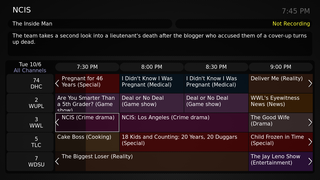
TiVo is a digital video recorder (DVR) developed and marketed by Xperi and introduced in 1999. TiVo provides an on-screen guide of scheduled broadcast programming television programs, whose features include "OnePass" schedules which record every new episode of a series, and "WishList" searches which allow the user to find and record shows that match their interests by title, actor, director, category, or keyword. TiVo also provides a range of features when the TiVo DVR is connected to a home network, including film and TV show downloads, advanced search, online scheduling, and at one time, personal photo viewing and local music playback.
A digital video recorder (DVR) is an electronic device that records video in a digital format to a disk drive, USB flash drive, SD memory card, SSD or other local or networked mass storage device. The term includes set-top boxes (STB) with direct to disk recording, portable media players and TV gateways with recording capability, and digital camcorders. Personal computers are often connected to video capture devices and used as DVRs; in such cases the application software used to record video is an integral part of the DVR. Many DVRs are classified as consumer electronic devices; such devices may alternatively be referred to as personal video recorders (PVRs), particularly in Canada. Similar small devices with built-in displays and SSD support may be used for professional film or video production, as these recorders often do not have the limitations that built-in recorders in cameras have, offering wider codec support, the removal of recording time limitations and higher bitrates.

Kodi is a free and open-source media player and technology convergence software application developed by the Kodi Foundation, a non-profit technology consortium. Kodi is available for multiple operating systems and hardware platforms, with a software 10-foot user interface for use with televisions and remote controls. It allows users to play and view most streaming media, such as videos, music, podcasts, and videos from the Internet, as well as all common digital media files from local and network storage media, or TV gateway viewer.

A home theater PC (HTPC) or media center computer is a convergent device that combines some or all the capabilities of a personal computer with a software application that focuses on video, photo, audio playback, and sometimes video recording functionality. Since the mid-2000s, other types of consumer electronics, including game consoles and dedicated media devices, have crossed over to manage video and music content. The term "media center" also refers to specialized application software designed to run on standard personal computers.

Hauppauge Computer Works is a US manufacturer and marketer of electronic video hardware for personal computers. Although it is most widely known for its WinTV line of TV tuner cards for PCs, Hauppauge also produces personal video recorders, digital video editors, digital media players, hybrid video recorders and digital television products for both Windows and Mac. The company is named after the hamlet of Hauppauge, New York, in which it is based.

Electronic programming guides (EPGs) and interactive programming guides (IPGs) are menu-based systems that provide users of television, radio and other media applications with continuously updated menus that display scheduling information for current and upcoming broadcast programming. Some guides also feature backward scrolling to promote their catch up content. They are commonly known as guides or TV guides.

MediaPortal is an open-source media player and digital video recorder software project, often considered an alternative to Windows Media Center. It provides a 10-foot user interface for performing typical PVR/TiVo functionality, including playing, pausing, and recording live TV; playing DVDs, videos, and music; viewing pictures; and other functions. Plugins allow it to perform additional tasks, such as watching online video, listening to music from online services such as Last.fm, and launching other applications such as games. It interfaces with the hardware commonly found in HTPCs, such as TV tuners, infrared receivers, and LCD displays.

Dreambox is a series of Linux-powered DVB satellite, terrestrial and cable digital television receivers, produced by German multimedia vendor Dream Multimedia.

SageTV Media Center, now open source, was a proprietary, commercial DVR and HTPC software for Mac OS X, Windows and Linux. It requires that the host computer have a hardware-based TV tuner card. The SageTV software has an integrated Electronic Programming Guide (EPG) that is updated via the Internet. The program provides a television interface for DVR, music, and photos on Windows and Linux. SageTV Media Center typically records in standard MPEG2, making it possible to transfer recordings to laptops or other devices. It also has a built-in conversion feature to transcode files into other formats compatible with iPod, PSP, cell phones and other portable devices.
ShowShifter, now obsolete, was a proprietary, commercial digital video recorder (DVR) and home theater PC (HTPC) software for Windows.
A media server is a computer appliance or an application software that stores digital media and makes it available over a network.
TiVo digital video recorders encompass a number of digital video recorder (DVR) models that TiVo Corporation designed. Features may vary, but a common feature is that all of the units listed here require TiVo service and use its operating system.
This is a comparison of digital video recorder (DVR), also known as personal video recorder (PVR), software packages. Note: this is may be considered a comparison of DVB software, not all listed packages have recording capabilities.

Mythbuntu is a discontinued media center operating system based on Ubuntu, which integrated the MythTV media center software as its main function, and did not install with all of the programs included with Ubuntu.

GB-PVR was a PVR application, running on Microsoft Windows, whose main function was scheduling TV recordings and playing back live TV. GB-PVR is no longer under active development and has been superseded by NextPVR, also known as nPVR.
Monsoon Multimedia was a company that manufactured, developed and sold video streaming and place-shifting devices that allowed consumers to view and control live television on PCs connected to a local (home) network or remotely from a broadband-connected PC or mobile phone. It was one of 5 major transformations initiated by Prabhat Jain, a Silicon Valley entrepreneur with 5 undergraduate and post graduate engineering degrees from Cal Berkeley and Univ of Vienna, Austria. On the even of Cisco acquiring Monsoon in 2017, EchoStar, the new parent of Sling sued Monsoon for patent infringement, having obtained confidential information about the date of the acquisition by Cisco from a Monsoon employee under murky circumstances. Monsoon settled the lawsuit by agreeing not to sell its products in the USA simply because it did not have the legal funds to fight mighty Echostar's legal maneuvers. EchoStar thus successfully removed its only competitor from the market place. This meant Monsoon's death knell.

Smuxi is a cross-platform IRC client for the GNOME desktop inspired by Irssi. It pioneered the concept of separating the frontend client from the backend engine which manages connections to IRC servers inside a single graphical application.
Unibox is a satellite, cable and terrestrial digital receiver. It has been distributed widely for use with Pay TV. It also enables the receiver to store digital copies of MPEG TS on internal harddisk or networked filesystems.
VBox Home TV gateway is a network-enabled live TV tuner and PVR HDTV set-top-box produced by VBox Communications Ltd.










